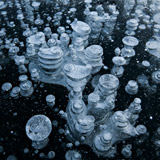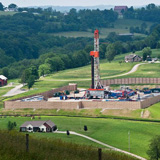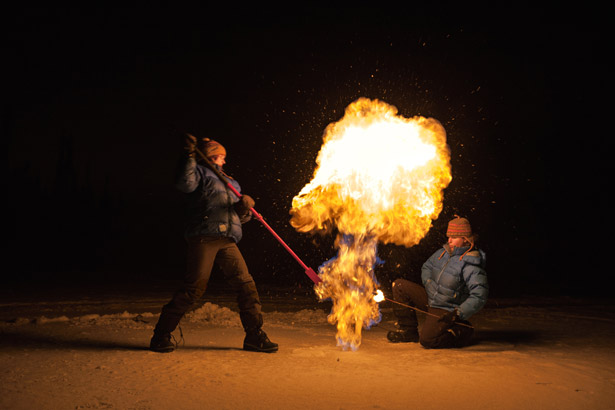The last rays of sun filter through the snow-covered spruces along the shore of Goldstream Lake, just outside Fairbanks, Alaska. Out on the lake Katey Walter Anthony stares at the black ice beneath her feet and at the white bubbles trapped inside it. Large and small, in layer upon layer, they spread out in every direction, like stars in the night sky. Walter Anthony, an ecologist at the University of Alaska Fairbanks, grabs a heavy ice pick and wraps the rope handle around her wrist. A graduate student holds a lighted match above a large bubble; Walter Anthony plunges the pick into it.
Gas rushing from the hole ignites with a whoomp that staggers her. “My job’s the worst, because usually you catch on fire,” she says, smiling. In the gathering twilight she and her team ignite one bubble after another.
The flames confirm that the bubbles are methane, the main component of natural gas. By counting and measuring them, Walter Anthony is trying to gauge how much methane is rising from Goldstream Lake—and from the millions of similar lakes that now occupy nearly a third of the Arctic region. The Arctic has warmed much faster than the rest of the planet in recent decades, and as the permafrost has melted, old lakes have grown and new ones have formed. Methane bubbles from their muddy depths in a way that is hard to quantify—until the first clear ice of fall captures a snapshot of the emissions from an entire lake.
Sometimes as Walter Anthony walks that ice, in Alaska, Greenland, or Siberia, a stamp of her boot is enough to release an audible sigh. Some lakes, she says, have “hot spots” where the methane bubbling is so strong that ice never forms, leaving open holes big enough to spot from an airplane. “It could be 10 or 30 liters of methane per day from one little hole, and it does that all year,” she says. “And then you realize there are hundreds of spots like that and millions of lakes.” By venting methane into the atmosphere, the lakes are amplifying the global warming that created them: Methane is a potent greenhouse gas. Carbon dioxide is the main one, because the atmosphere holds 200 times as much of it. But a given amount of methane traps at least 25 times as much heat—unless you burn it first. Then it enters the atmosphere as CO₂.
That’s the other side of this Jekyll-and-Hyde story: A lot of methane is being burned these days. In the past decade the technology called hydraulic fracturing, “fracking” for short, has enabled drillers in the United States to extract natural gas from deeply buried shales they couldn’t tap before. Natural gas supplies have surged; prices have plummeted. Fracking is now spreading around the world, and it’s controversial. The gas boom has degraded landscapes and polluted water. But it has also had environmental benefits. Natural gas burns much cleaner than coal. In part because American power plants have been switching from coal to cheap gas, U.S. emissions of CO₂ from fossil fuels fell last year, even as the world set another record.
The catch is, methane emissions are rising. What’s coming out of Arctic lakes is troubling, Walter Anthony says, because some of it seems to be coming not from bottom mud but from deeper geologic reservoirs that had hitherto been securely capped by permafrost—and that contain hundreds of times more methane than is in the atmosphere now. Still, most methane emissions today come from lower latitudes, and most are related more directly to human activities. A growing amount seems to be leaking, for instance, from gas wells and pipelines. Just how warm Earth gets this century will hinge in part on how we balance the good and bad of methane—on how much of it we capture and burn, and how much we inadvertently let loose.
Methane is the simplest hydrocarbon—a single carbon atom surrounded by four hydrogen atoms. It usually forms when larger organic molecules are broken down, either by microbes or by heat. The microbes produce it when they eat dead plant matter in wet, oxygen-poor environments. They’re the source of the methane bubbling up from Goldstream Lake; from swamps and marshes all over; from human-made rice fields, landfills, and manure lagoons; and from the stomachs of cows and other ruminants. Termites emit a lot of methane too.
Most of the natural gas we tap for fuel, however, was formed not by microbes but by heat and pressure deep underground—as oil and coal were, and often in the same places. In coal mines methane is an explosion hazard; in oil fields it was long considered a nuisance to be burned off or, worse, vented directly into the atmosphere. Liquid oil was more valuable as fuel and much easier to transport to markets. Then pipelines built during the post–World War II construction boom made gas more transportable. The energy industry began to exploit massive natural gas reservoirs in places like Russia, Qatar, and Iran.
The United States produces the bulk of its own gas, but U.S. production peaked in 1973. By 2005 the country seemed to be running short, and the industry was building expensive new tanker terminals to import liquefied natural gas. The fracking boom changed that. Since 2005 gas production from deep shales has increased more than tenfold; it now accounts for more than a third of total production, which last year surpassed the 1973 record. Within a decade, according to a Department of Energy (DOE) forecast, the U.S. will become a net exporter of gas.
Estimates of how much gas is locked up in shales and how long the boom can last have varied widely. In 2011 DOE put the amount of “unproved resources” of shale gas at 827 trillion cubic feet; in 2012 it cut that estimate by more than 40 percent. Production from fracked wells has declined faster than DOE analysts had expected. So some critics believe the boom is a bubble that will soon burst. But DOE still projects that U.S. gas production will rise rapidly and that shale gas will make up half the total by 2035.
And deep shales are not the last methane source. DOE and the industry are trying to figure out how to tap the largest one of all—the methane hydrates that lie frozen under vast areas of seafloor and Arctic permafrost. Worldwide, hydrates may contain more energy than all other fossil fuels combined. They’re usually snow-white and look like ice, but they’re strange stuff, and extracting the methane is tricky. Each molecule is trapped in a cage of water molecules that’s stable only at high pressure and low temperatures; change either just a bit, and the cage crumbles. The escaping methane balloons in volume by a factor of 164.
Oil companies working on continental margins have to take care that extracting oil through an overlying hydrate layer does not disrupt it and perhaps damage the well. Climate scientists worry that global warming could destabilize hydrate layers, on land or at sea, triggering a massive methane release that would amplify the warming. A few scientists take seriously a catastrophic scenario in which the release happens rapidly, within a human lifetime, and the planet’s temperature spikes.
The atmospheric methane concentration has risen nearly 160 percent since preindustrial times, to 1.8 parts per million. For a few years, from 1999 to about 2006, it seemed to level off. Some researchers credit Asian rice farmers, who began draining their paddies during the growing season to conserve water—which reduced methane emissions as well. Another theory credits the oil industry, which started capturing and selling methane it used to simply vent. Since 2006, though, atmospheric methane has been rising again. Many observers believe it’s no coincidence that the number of wells punched into deep shales has been soaring too.
The largest U.S. shale formation, the Marcellus, lies about a mile under the Appalachian Mountains, in an arc that runs from West Virginia to New York through Ohio and Pennsylvania. The Pennsylvania stretch is pretty country: rolling hills and pastures and, in the northwest, the forests of the Pennsylvania Wilds, which boast some 2,000 trout streams and one of the darkest night skies in the East.
These days tank trucks, sand haulers, flatbeds stacked with pipe, and cement mixers rumble continually over the winding two-lane roads. Here and there in patches cut from forest or farm are flattened, four-acre mounds of fresh dirt. For a few weeks at a time tall derricks rise from these drill pads, and the trucks and trailers congregate around them. Contaminated water from the new wells pours into tank trucks or into lagoons lined with dark plastic. The derricks soon disappear, but the wells stay, connected by clusters of green pipes and valves to permanent new pipelines, condensate tanks, and compressor stations. Much of Pennsylvania has been transformed since 2008.
The boom’s roots go back to the 1980s and to Texas, where a wildcatter named George Mitchell, facing dwindling reserves, began probing the Barnett Shale near Dallas. Black shales, the compressed mud of ancient seas, were known as petroleum source rocks. But over geologic time much of the oil and gas had migrated out of the shales into porous sandstone traps—and that’s where the industry sank its wells. Wells ending in shale never yielded much; the shales were too dense and impermeable to allow gas to flow.
Mitchell Energy’s workaround, developed over 20 years with support from DOE, became the recipe for the fracking boom. It has two parts. First, drill down to the shale, then continue drilling horizontally for a mile or so inside it; that puts more gas close to the well. Second, inject millions of gallons of water, chemical lubricants, and sand at high pressure to shatter the shale, allowing methane to rush into the well.
The gas from fracked wells has benefited consumers; 55 percent of the homes in the U.S. have gas heat, and prices last winter reached a ten-year low. In Pennsylvania the boom has revived businesses; created some 18,000 jobs, by the state’s reckoning; and paid millions of dollars in lease-signing bonuses and royalties. However, some landowners who leased their land to gas companies have since had second thoughts.
Sherry Vargson is one. In 2008 Chesapeake Energy began drilling on her family’s 197-acre dairy farm in Granville Summit, in northeastern Pennsylvania. In June 2010, after a crew had been working on the well, Vargson turned on her kitchen tap to find it backed up with what she thought was air. “It was like drawing a glass of Alka-Seltzer, very sizzly and bubbly,” she recalls. Testing showed the water contained more than twice the methane that’s considered an explosion threat. Chesapeake has been supplying her with bottled water ever since, while arguing that the contamination is natural. Meanwhile Vargson’s monthly royalty checks have shrunk from more than $1,000 to less than $100, as production from the gas well has plummeted.
The industry’s main argument in attempting to reassure a worried public in Pennsylvania and elsewhere has been that shales typically lie thousands of feet below drinking-water aquifers. So contamination, whether by shale gas or fracking wastewater—which contains fracking chemicals, salt, heavy metals, and radioactive elements leached from the rock—should be physically impossible. The argument makes intuitive sense, but the jury is still out. Duke University scientists have recently reported evidence that fluids—albeit not fracking fluids—have migrated upward from the Marcellus Shale through natural fissures.
In an earlier study the Duke researchers sampled 60 private water wells in northeastern Pennsylvania and found no sign of fracking fluids. But they did find that methane levels were on average 17 times higher in wells near drilling sites and that some of the methane had the chemical signature of shale gas. It may have leaked into the shallow aquifers, they said, through faulty casings around the gas wells. The Pennsylvania Department of Environmental Protection (DEP) also blamed faulty casings in 2009 when it fined Cabot Oil & Gas for contaminating the drinking supplies of 19 homes in Dimock Township, 60 miles east of the Vargson farm. In that case the methane came not from the shale but from shallow deposits traversed by the gas wells. DEP has also fined gas companies for mishandling fracking wastewater and allowing spills that polluted creeks and rivers.
In Pennsylvania and elsewhere, shale-gas drilling has raced far ahead of efforts to understand and limit its impact. So far, however, its impact seems much smaller than that of coal mining—which in Pennsylvania has caused far worse river pollution, in West Virginia has lopped the tops off numerous mountains, and in the U.S. still kills hundreds of miners a year, mostly through black lung disease. The comparison is relevant because cheap natural gas is reducing coal burning. As recently as 2007, coal generated nearly half of U.S. electricity. Last March its share fell to 34 percent.
John Hanger, a Pennsylvania lawyer who helped author the state’s renewable-energy standards, ran the DEP from 2008 to early 2011. Though he tightened regulations on the gas industry and handed out substantial fines, he was attacked by opponents who wanted a complete halt to fracking. Hanger believes such critics are missing the big picture. “The massive switching from coal to gas has done more to clean Pennsylvania’s air, and America’s air, than probably any other single thing we’ve ever done,” he says.
Unlike coal, natural gas burns without spewing sulfur dioxide, mercury, or particulates into the air or leaving ash behind. And it emits only half as much carbon dioxide. The greenhouse gas inventory compiled by the U.S. Environmental Protection Agency (EPA) shows that the nation’s CO₂ emissions in 2010 were lower than in 2005 by just over 400 million metric tons, or 7 percent. (Preliminary data for 2011 indicate a further decrease.) Reduced emissions from power plants, mostly because many have switched from coal to gas, accounted for a bit over a third of that.
Some environmentalists who once welcomed shale gas with precisely that expectation changed their minds after watching the boom in Pennsylvania. But Hanger hopes it spreads around the world, as it seems likely to. “In China they’re sitting on potentially huge supplies of shale gas,” he says. “It would be an enormous climate benefit if China were to substitute gas for some of its coal burning. And it’s an immediate benefit—you don’t have to wait until 2040 or 2050.”
Unless too much methane leaks into the atmosphere. As U.S. CO₂ emissions fell between 2005 and 2010, methane emissions rose. By 2010, EPA says, the rise was equivalent in global warming potential to around 40 million metric tons of CO₂ annually, which means it offset 10 percent of the CO₂ decline. More than half of that methane increase, says EPA, came from the natural gas industry—the country’s biggest emitter.
Judging by EPA’s numbers, fracking still seems like a clear win for the climate. But some scientists, notably Robert Howarth and his coworkers at Cornell University, believe EPA has underestimated methane emissions and, more important, the global warming potential of each methane molecule. They argue that methane leaking from wells, pipes, compressors, and storage tanks actually makes shale gas worse for the climate than coal. Other researchers question Howarth’s approach. The debate persists in part because methane numbers are so uncertain.
New rules issued by EPA this year will require the gas industry to measure its emissions and also to reduce them. One of the biggest leaks occurs when a fracked well is completed and high-pressure fracking fluids surge back up the well, bringing methane with them. The new rules will require gas companies to start capturing that methane by 2015, using technology that’s already required in Wyoming, Colorado, and parts of Texas.
Some experts consider methane capture a great opportunity: an easier way than controlling CO₂ to slow global warming, at least in the short term, because small amounts of methane make a big difference and because it’s a valuable fuel. China, for instance, the world’s largest coal producer, vents huge amounts of methane from its mines to prevent explosions. In the 1990s, when Egyptian geologist Mohamed El-Ashry headed the Global Environment Facility, an agency created by the United Nations and the World Bank, it devoted ten million dollars to projects that siphoned methane from several Chinese mines and delivered it as fuel to thousands of nearby households. Hundreds of such projects await funding worldwide, El-Ashry says.
Drew Shindell, a climate scientist at NASA’s Goddard Institute for Space Studies, recently led a global team of scientists in analyzing seven methane-reduction strategies, from draining rice fields to capturing the gas that escapes from landfills and gas wells. Unlike CO₂, methane affects human health, because it’s a precursor of smog. When health impacts are included, Shindell’s group found, the benefits of methane controls outweigh the costs by at least 3 to 1, and in some cases by as much as 20 to 1.
“There are some sources that are difficult, if not impossible, to control,” says Shindell. “The Arctic emissions—I’d probably vote those as being near impossible. But then you have long-distance gas pipelines, and we know exactly how to control leaks from those: put in and maintain high-quality seals. And there are other places, especially in oil, gas, and coal production. It’s really straightforward to get a substantial fraction of methane emissions under control.”
Last spring, as the annual thaw began in Alaska, Katey Walter Anthony heard from her friend Bill Wetzen, who owns Goldstream Lake and sometimes brings her coffee out on the ice. When Wetzen bought the property 20 years ago, he built his bungalow about 20 yards from the lake; by last year it was nearly at the water’s edge. Now, Wetzen said, with the permafrost thawing beneath it, the walls and floors were tearing apart. He was going to have to move.
Also last spring, DOE-funded researchers on Alaska’s North Slope successfully tested a method of extracting methane from buried hydrates. Though the process “may take years” to become economically viable, said the DOE press release, “the same could be said of the early shale gas research ... that the Department backed in the 1970s and 1980s.” If even a small fraction of methane hydrates becomes recoverable, DOE estimates, that could double U.S. gas resources.
Some of the methane bubbling from Arctic lakes, Walter Anthony says, might come from hydrates. Around 56 million years ago, in the Paleocene, a long planetary warming culminated in a sudden temperature spike of 9°F; many scientists suspect a massive destabilization of methane hydrates. Most, including Walter Anthony, do not think such a catastrophe is likely now. But Arctic methane could add a lot to global warming over the next few centuries.
“If we could only capture it, it would make a great energy source,” Walter Anthony says.







 Buy NG Photos
Buy NG Photos Special Issues
Special Issues